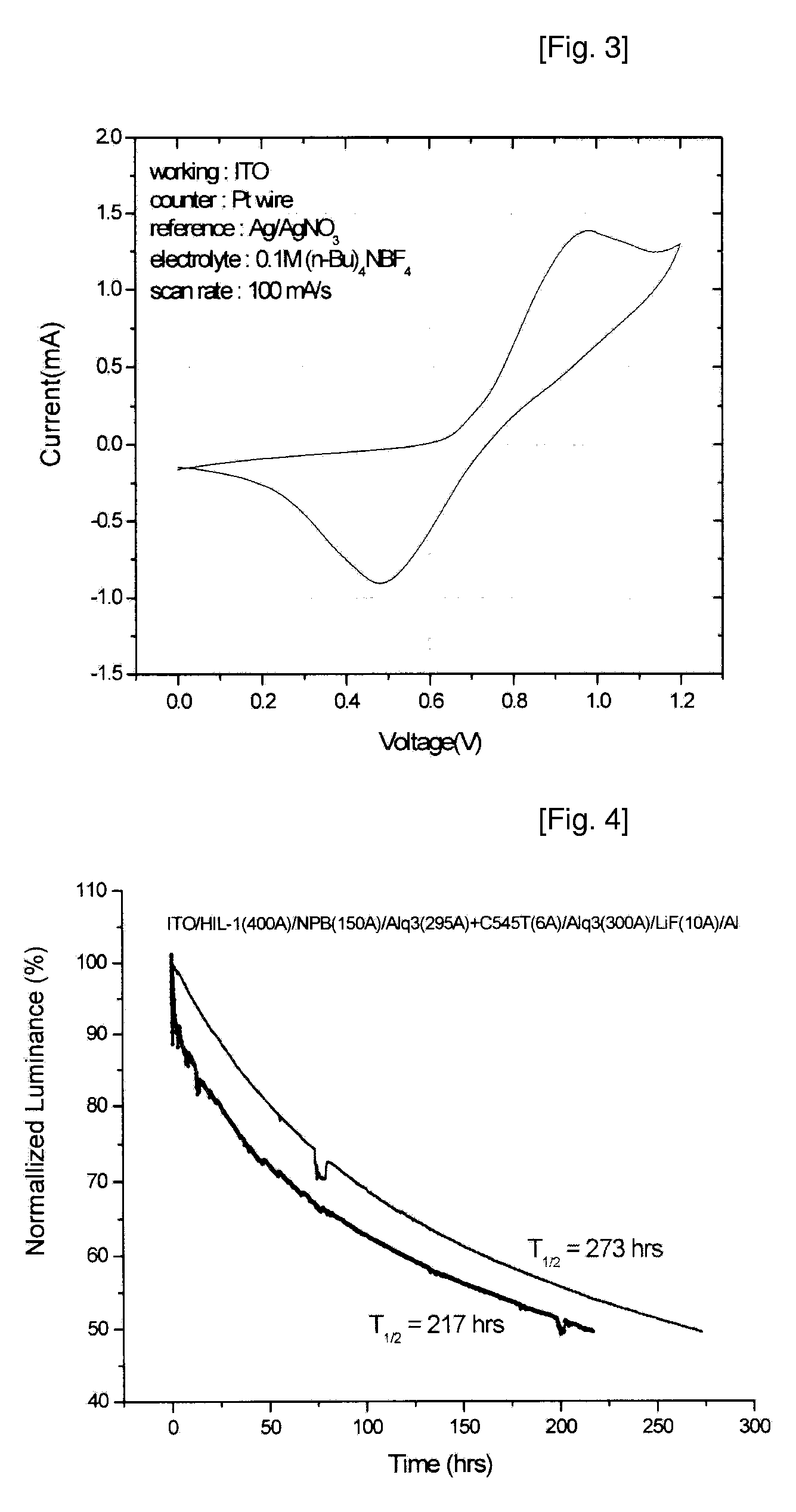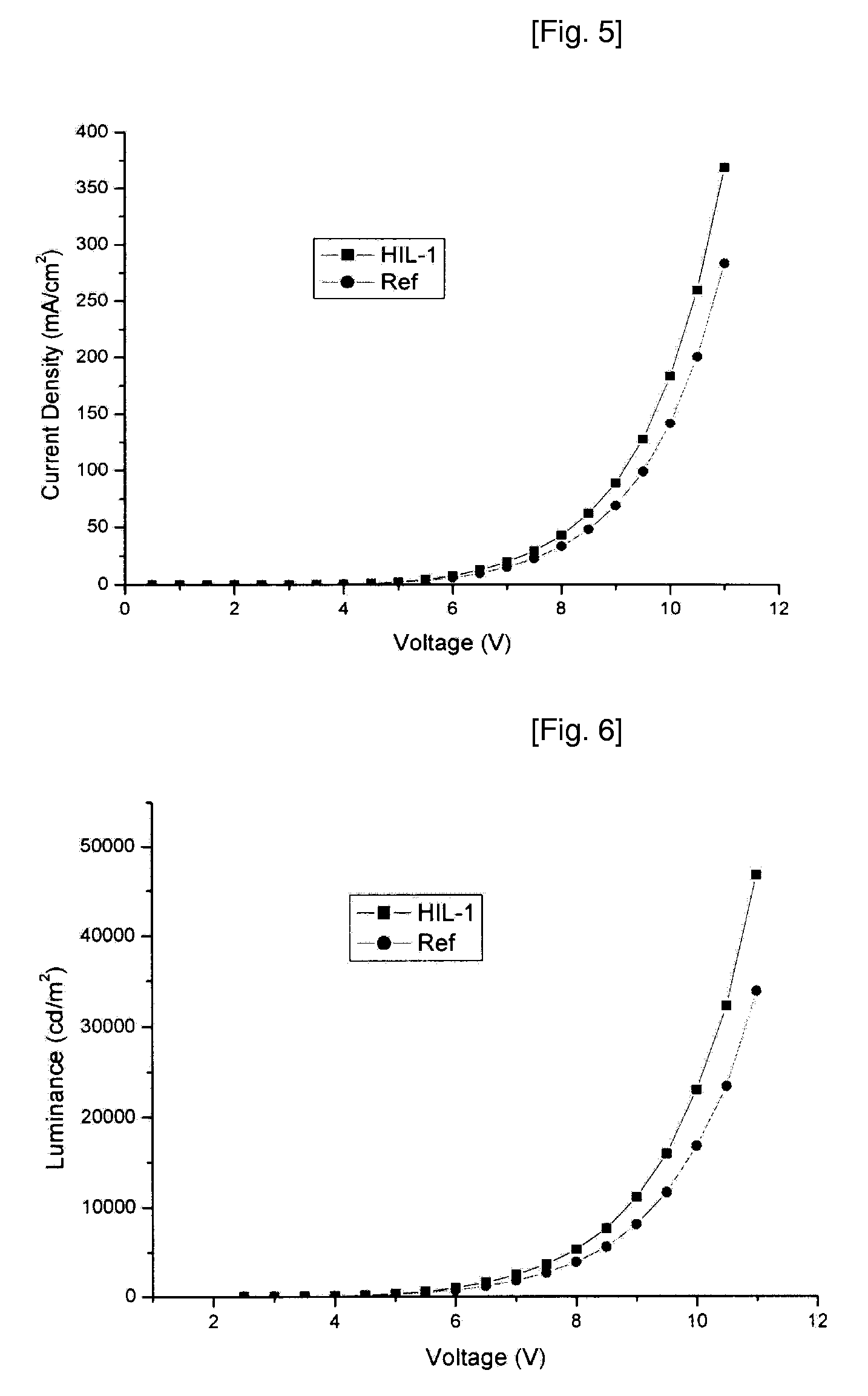Deuterated aryl amine compound, preparation method thereof, and organic light emitting diode using the same
a technology of deuterated aryl amine and compound, which is applied in the direction of discharge tube luminescnet screen, other domestic articles, natural mineral layered products, etc., can solve the problems of luminescence efficiency, lowluminance and thermal stability of commercialized electro-luminescence devices, etc., to improve luminescence efficiency, current efficiency, and luminance efficiency.
- Summary
- Abstract
- Description
- Claims
- Application Information
AI Technical Summary
Benefits of technology
Problems solved by technology
Method used
Image
Examples
example 1
[0040](1) Preparation of triphenylamine-d15
[0041]
[0042]After, 5 g (30.9 mmol) of bromobenzene-d5 and 1.52 g (15.5 mmol) of aniline-d5 were dissolved in 150 mL of toluene, 0.43 g (0.465 mmol) of tris(dibenzylidene acetone dipalladium) was added thereto under a nitrogen atmosphere. To the resulting mixture, 1.79 g (18.6 mmol) of NaOBut, followed by 0.19 g (0.93 mmol) of (t-Bu)3P were added. The resulting mixture was refluxed while stirring for 12 hours. The completion of the reaction was identified by a TLC. After the reaction was completed, the temperature was lowered to room temperature. The reaction solution was poured onto a thin silica pad so as to perform a short chromatography, and the fraction containing the desired product was washed with dichlorometane. The residual solution was evaporated under a reduced pressure to remove the solvent. The residue was then purified by a chromatography using 10% dichlorometane in n-hexane, to obtain 3.55 g (yield: 88%) of triphenylamine-d15 ...
example 2
[0057](1) Preparation of N,N-di-naphtalelen-1-yl-anthracenyl-9,10-diamine
[0058]
[0059]5 g (14.9 mmol) of 9,10-dibromoanthracene and 4.26 g (29.8 mmol) of 1-aminonaphtalene were dissolved in 200 mL of toluene, to which 0.41 g (0.447 mmol) of tris(benzylidene acetone dipalladium) was added under a nitrogen atmosphere. To the resulting mixture, 0.18 g (0.89 mmol) of P(t-Bu)3, followed by 1.72 g (17.9 mmol) of NaO-t-Bu were added. The reaction solution was refluxed while stirring for 24 hours. When the reaction was completed, the reaction solution was filtered at a high temperature through a thin silica gel pad to remove palladium. The filtrate was worked-up using ethyl acetate and water. Ethyl acetate layers were dried with MgSO4 and then evaporated under a reduced pressure to remove most of the solvent. The residue was filtered to obtain a first brown solid product. After the filtrate was again evaporated under a reduced pressure, the residue was dissolved in a small amount of ethyl ac...
PUM
| Property | Measurement | Unit |
|---|---|---|
| temperature | aaaaa | aaaaa |
| temperature | aaaaa | aaaaa |
| temperature | aaaaa | aaaaa |
Abstract
Description
Claims
Application Information
 Login to View More
Login to View More - R&D
- Intellectual Property
- Life Sciences
- Materials
- Tech Scout
- Unparalleled Data Quality
- Higher Quality Content
- 60% Fewer Hallucinations
Browse by: Latest US Patents, China's latest patents, Technical Efficacy Thesaurus, Application Domain, Technology Topic, Popular Technical Reports.
© 2025 PatSnap. All rights reserved.Legal|Privacy policy|Modern Slavery Act Transparency Statement|Sitemap|About US| Contact US: help@patsnap.com



